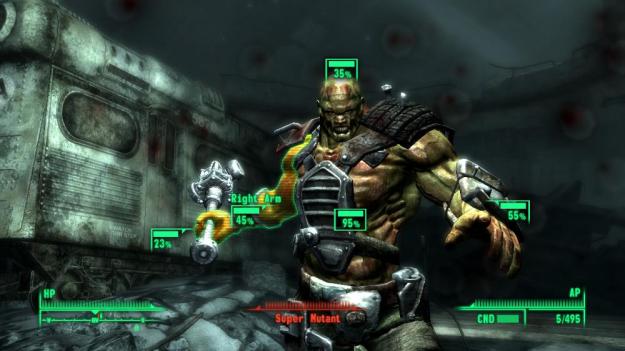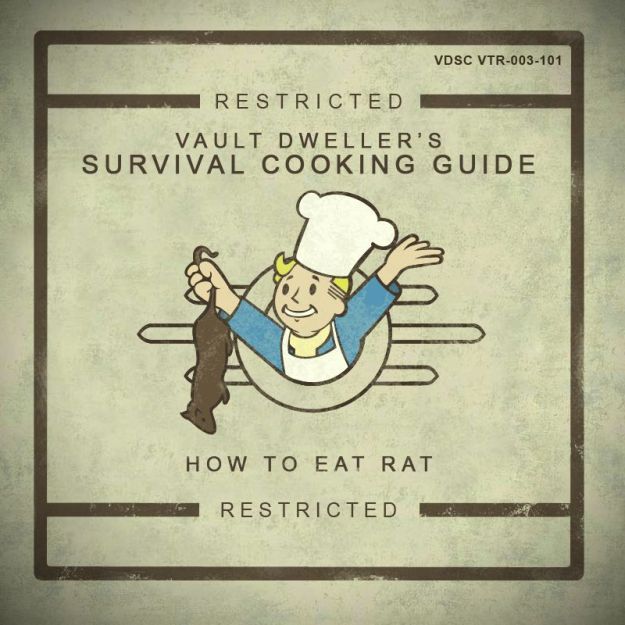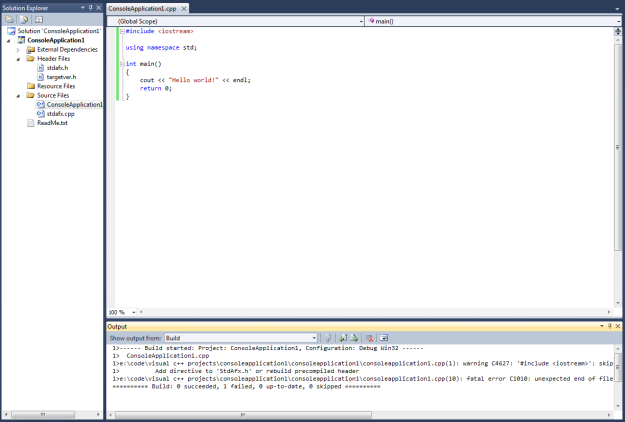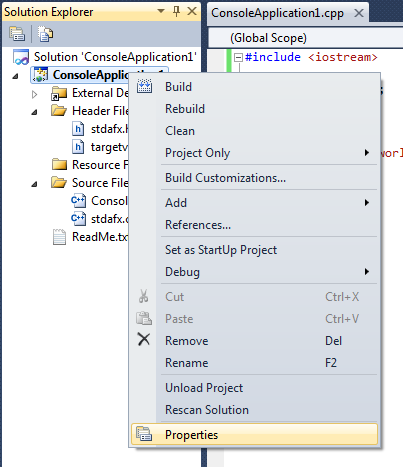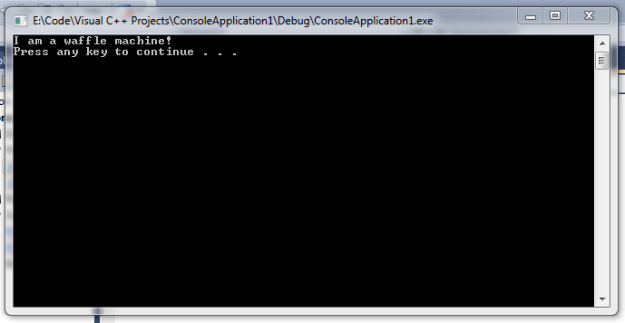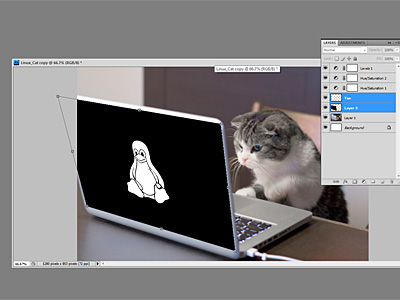I’ve talked about Demon’s Souls here before. That was about a year and a half ago. As it was one of the main reasons I decided to purchase a PlayStation 3 instead of an Xbox 360, it was one of the first games I bought after acquiring the system in 2010. In other words, I’ve been playing this game for almost three years now, and I keep coming back to it for more. There is something about Demon’s Souls that is genuinely compelling, more-so than any other game I can remember from the last few years. In fact, Demon’s Souls is so good that it’s turned me into somewhat of a game snob. The same kind of thing happened when I became accustomed to strong ale, in particular Arrogant Bastard Ale by Stone Brewing Co. After drinking enough of that stuff, everything else kind of lost its taste. The way Stone describes its beer is intended to come off as elitist and arrogant, which is hilarious in itself, but it’s also funny how closely it describes the way I feel about Demon’s Souls (with a few tweaks):
This is an aggressive [game]. You probably won’t like it. It is quite doubtful that you have the [skill] or sophistication to be able to appreciate [a game] of this quality and depth. We would suggest that you stick to safer and more familiar territory – maybe something with a multi-million dollar ad campaign aimed at convincing you it’s [the most awesome thing ever], or one that implies that their [multiplayer and social features] will give you more [friends]. Perhaps you think multi-million dollar ad campaigns make things [more fun]. Perhaps you’re mouthing your words as you read this.
Of course, I’m kidding. But it’s kind of sad that so many people only ever drink tasteless fizzy yellow beer, and so many people only ever play games that are backed by major corporations, that lack any element of challenge or creativity, and that are purely motivated by sales numbers and review scores. Demon’s Souls is not a perfect game. There are a few things From Software could have improved. But my list of complaints is relatively short, so let’s get those out of the way first:
- Corpses shouldn’t be all that animated. I can understand if a body moves when you step on it, but why do they have to flail about so much?
- Often, the only practical way to figure things out is to read the wiki – particularly when it comes to some of the bosses (such as Flamelurker, Maneater, or even Leechmonger), unless you enjoy starting over at the beginning of a level with your health reduced to half and nothing to show for it.
- The interface is rather clunky, especially when comparing weapon and armor statistics. Again, your best bet for choosing the right weapon is probably to read the wiki.
It actually took a fair amount of head scratching to come up with that short list, which should speak volumes on behalf of the quality of the game. Now let’s look at what Demon’s Souls does right.
Hard but fair
Every game should balance its difficulty in such a way that it is neither too easy nor too hard. That much is obvious – and I’m sure it’s easier said than done from a development standpoint – but where most games totally fail at this, Demon’s Souls gets it just right. When I purchased Demon’s Souls, the guy behind the counter cautioned me, saying that “it was a real controller breaker” for him. I have to say that I never had the urge to crush my controller to pieces or throw it at the wall while I was playing Demon’s Souls. I have experienced that level of frustration with a number of other games. For instance, in God of War, there is a section in Hades where you have to climb these spinning columns covered with spikes that kill you in one hit. It’s nearly impossible to climb to the top. If you’ve played the game, you will definitely remember this part:

Pure evil.
The reason I remember it so well is because I had never been so frustrated with a video game in my life… until I played Dead Rising 2 and I had to fight this piece of crap:

Possibly the worst boss fight ever.
Actually, all of the boss fights in Dead Rising 2 are tedious and cheap. Some other rage inducing games (off the top of my head) include Uncharted: Drake’s Fortune, Deus Ex: Human Revolution, Killzone 2, Resistance 2, Psychonauts, and Assassin’s Creed. These games are generally very easy with the exception of a few segments where the difficulty is increased to such an extreme level that it requires more luck than skill to get past. To alleviate this problem, these games usually give you a checkpoint right before you are sure to fail, so you can experience the frustration of that segment over and over again until you get the timing exactly right (or whatever it is you have to do) and make it to the next checkpoint. Demon’s Souls never does this. Don’t get me wrong – you will die if you aren’t careful. But, if you are careful, chances are you will make it through most of the game alive.
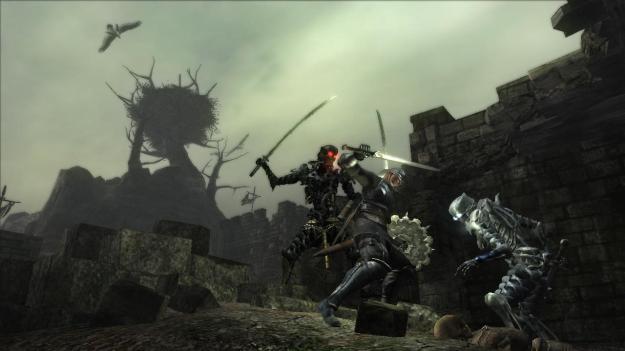
Don’t be like this guy – he’s not being careful.
Blogger Nick Burgener explains this point very eloquently:
While virtually every press release has touted the game’s challenging difficulty, and many gamers have accused it of being exceedingly cheap, tedious, and frustrating, the simple fact of the matter is that Demon’s Souls is not that hard, as long as you approach it intelligently… It can be very challenging at times, yes, but I think Demon’s Souls represents an ideal for challenging gameplay; it’s not afraid to punish you for your failures, which makes your successes that much more meaningful, and it rewards you greatly for playing well. The challenge is neither tedious nor frustrating; it’s intelligent and personal. As long as you play intelligently, it becomes a surprisingly easy game. (source)
I wouldn’t say Demon’s Souls is ever easy. Aside from that, I couldn’t have put it better.
The story takes a back seat
I’m not of the mindset that games should never have stories. Good games usually benefit from good stories. But some games are so heavy-handed with their stories that their gameplay suffers as a result. Take Dragon Age 2, for example, where the gameplay was dumbed down so badly that all that remained was a shell of an RPG – the only choices to be made in the game are superficial at best; the combat is simplistic and repetitive; the player is shoehorned into following a predetermined path. Apparently, BioWare thinks it’s more important that their game tells a mediocre story than that it implements solid RPG mechanics and interesting gameplay.

We could talk about Mass Effect as well. But BioWare is not the only developer that is guilty here. The Witcher is a pretty solid RPG – there are a lot of choices to make that have interesting repercussions throughout the game; the skill tree is immense; it would take multiple playthroughs to experience everything the game has to offer. But the story, as profound as it’s supposed to be, is boring and trite. These people and the world they live in are screwed no matter what you do, because reality is grim and dark and all that. Normally I can overlook this kind of thing in games, but The Witcher beats you over the head with its story, its lore, its characters, its morality and philosophy to the point of exhaustion. I love the way Dr. Atomic puts this on his blog:
Consider Geralt’s two swords; as a monster hunter, he carries one made of steel for use against men, and one made of silver for use against monsters. Ah, but as Geralt says, “both are for monsters.” Do you get it? Humans are monsters. If you didn’t catch that, the game will ram it down your throat against and again with all the subtlety of a sledgehammer. Poor Geralt can’t swing a sword without hitting someone prattling on about “Hey, remember that time we raped/murdered/slaughtered that entire village? Good times, mate!” or spewing a stream of profanity that would make a sailor blush. (source)
Most of the game (aside from running fetch quests) amounts to choosing dialog options and watching cutscenes. It asks you to make some really tough decisions, but it’s hard to care about any of the characters because they all suck so bad. Geralt is no better. His personality can be summed up in one word: indifferent.
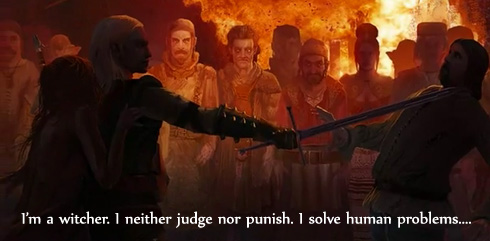
These people are all jerks, but Geralt doesn’t really care and neither should you.
Demon’s Souls, in contrast, doesn’t get bogged down with its story. There’s actually a great story and a heap of lore to be found in the in-game descriptions of characters, items, and locations, but the better story is the one that’s told through your actions. The gameplay is exciting! The boss fights are intense! These are things I actually want to share with other people – Did I tell you about the time I beat Maneater with a shred of health left? I was literally jumping up and down!
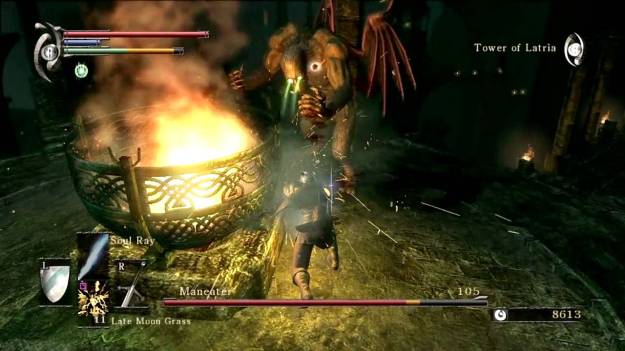
One of the toughest boss fights in the game.
No dialog trees
There has got to be a better way to role play than choosing conversation responses. I can appreciate a game that gives you different ways to develop your character, and I realize that the dialog tree is a long established RPG tradition. But every time I see one of these I physically cringe:
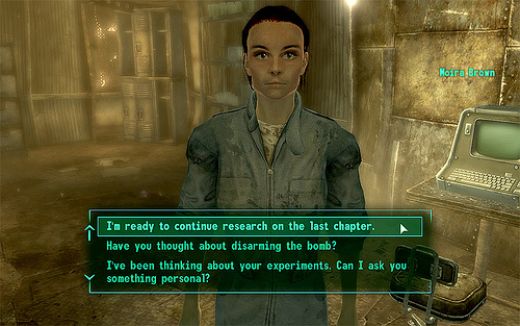
Oh crap, not another dialog tree…
This could be a matter of personal preference, but if I wanted to read a book I would pick something with a much better story than this. What do I really need to know about Moira from Fallout 3? And why is she so eager to discuss her life story with me? For all she knows, I could be role-playing a murderous psychopath. It’s either that or a wussy pushover since there’s usually not a middle ground when it comes to conversation options.

The neutral option is generally preferred.
In contrast, what does Blacksmith Ed tell you about himself? Absolutely nothing! He’ll tell you about his profession, but only what you need to know: “If you need a blacksmith, bring me demons’ souls.” The result: less of my time wasted on boring plot and character details.
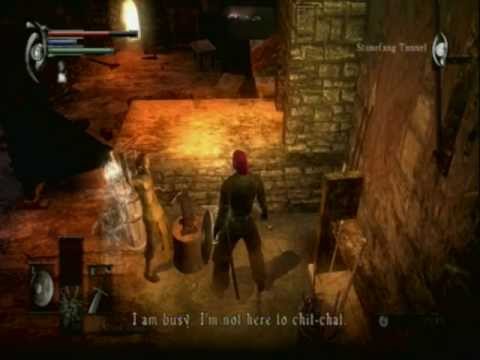
He even tells you to get lost. I love it!
Deep, complex RPG mechanics
While most developers are busy stripping RPG mechanics out of their games to provide a more streamlined experience to the casual crowd (Skyrim, Dragon Age 2, Mass Effect), it’s possible to spend hours deciding how to customize your character and equipment in Demon’s Souls. Will you put all the souls you accumulate into increasing your magic power or increasing your capacity for magic spells? Will you spend all your precious upgrade stones acquiring a better spear or a more powerful bow? Chances are you won’t have enough to do both in one playthrough, so you have to decide. Will you give the Yello Demon’s Soul to Blacksmith Ed to forge an incredibly powerful catalyst, or to Sage Freke to learn an unstoppable magical attack? Of course, you could simply consume it for a ridiculous amount of souls. It sure is tempting…

You won’t be getting another Yellow Demon’s Souls anytime soon, so choose wisely.
These kinds of decisions make for a compelling meta-game that you could be playing for years to come, which is why so many people are still playing Demon’s Souls. SnapSlav summarizes my points thus far very well over at No Mutants Allowed:
Demon’s Souls immediately sets itself apart from other RPGs in its unique design. Unlike many RPGs, Demon’s Souls avoids lengthy narrative and exposition, in favor of giving the player full control of their destiny. As a whole, the distinct and creative mechanics of the game are so vast that entire Wiki articles have been dedicated to fleshing out and explaining each particular one. (source)
Not convinced yet? Check out the articles on character tendency and world tendency on the wiki, and there’s a lot more where that came from.
Creative use of multiplayer
Between Quake 3 Arena, Unreal Tournament, Battlefield, Call of Duty, the Enemy Territory games, and a plethora of Half-Life mods, I’ve sunk literally hundreds of hours into multiplayer gaming. I started to lose interest when perks became a popular feature in multiplayer games, after which it always felt like a grind to unlock the next weapon or powerup. Players that have unlocked better perks have an unfair advantage over players that haven’t, which enables them to unlock even more perks, which gives them even more of an advantage. This is by far the most popular model in multiplayer games today.
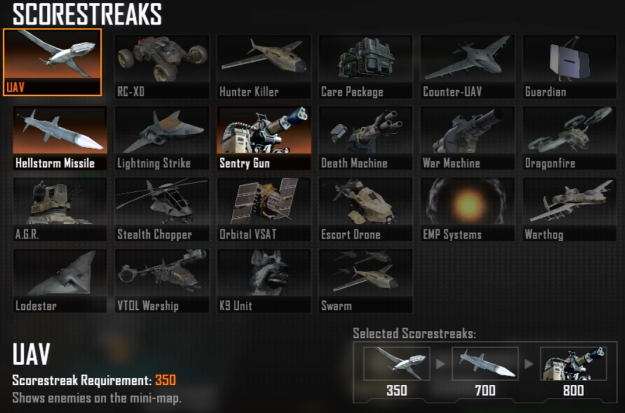
You want these, don’t you?
There’s also a groupthink mentality that is present in multiplayer games today. I believe this is why the Xbox 360 is arguably more popular than the PlayStation 3, and why games like Halo and Call of Duty sell better than other games that are better in almost every respect. If you have an Xbox 360 and play Halo and Call of Duty, then you are part of a huge group of gamers. It means you suddenly have something to talk about with the people that play those games after school or work, even though there’s not much worth talking about in those games.

Remember that time the red guys were on the ATVs, and the blue guys were shooting at them? That was awesome.
I won’t describe all the details about the multiplayer in Demon’s Souls, since you can read about it on the wiki. Suffice it to say that it’s totally unique. Playing a level with a blue phantom could mean the difference between life and death, and being invaded by a black phantom is an absolutely terrifying event if you aren’t prepared for it.

Victory in Demon’s Souls is worth sharing.
Finally, I can’t tell you how many times I was saved by a message that warned of an imposing ambush. No other game encourages you to help other players by leaving messages for them in their worlds.
A refined experience
These days, developers are always trying to up the ante when it comes to the scope of their games. “You thought Rome was big in Assassin’s Creed: Brotherhood? Wait ’til you see Constantinople in Assassin’s Creed: Revelations!” “Forget Constantinople, Skyrim is so big it will take you hours to cross on foot!” (Don’t try this at home, it will literally bore you to death.) I actually gleaned a lot of enjoyment from Skyrim before I realized how irritated I had become with it. But there is an inherent design problem in games where the player can “go anywhere and do anything.” How do you quality test a piece of software like that? The only practical way is to draw a line once you feel you’ve eliminated enough bugs. And, seriously, don’t get me started on the bugs…
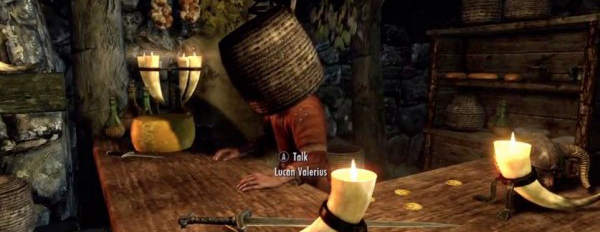
’nuff said.
As for infinite quests, they are hardly something to be desired when they amount to nothing but fetch quests and random, meaningless encounters.
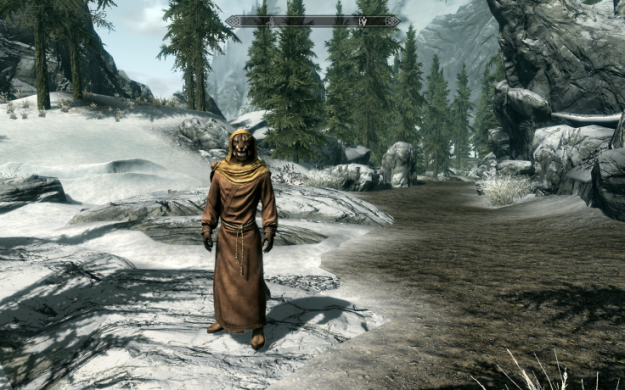
Do me a favor and tell that guard over there you never saw me. Or don’t. On second thought, it really doesn’t matter.
Demon’s Souls may not have a map the size of the Amazon Rainforest, but it also has a lot less bugs as a result. (See what I did there?!) It may not have infinite quests, but the quests it does have are worthwhile. It may not have thousands of fully voiced NPCs, but the characters it does have are memorable and charming. It’s a rock solid game with relatively few, minor bugs. The only one I can think of that ever bothered me was the corpse behavior I mentioned earlier.
Bucketlist
This post has gone on long enough, so I’ll just briefly mention some other things that make Demon’s Souls so good.
- The atmosphere is totally creepy, and is far scarier than games that are supposed to be scary (Dead Space, F.E.A.R., Resident Evil…). Fantasy horror might be my new favorite combination of genres.
- The level design is smart and unique. What other game has a level like Tower of Latria, or Shrine of Storms, or Valley of Defilement (my absolute worst nightmare)?
- The graphics (or aesthetics, if you prefer) are extremely polished. Lots of games that tout realism as a strong point (Skyrim, Assassin’s Creed…) look like garbage next to Demon’s Souls, even though it’s several years older.
- The soundtrack is subtle and beautiful. Most of the time, you don’t hear any music at all, which sets the mood appropriately given the places you find yourself in.
- Cutscenes are few and far between. When there are cutscenes, they’re short.
Conclusion
Unfortunately, there are not a ton of people that are willing to give a game like Demon’s Souls a fair chance, which means we will only get more shooters and dumbed down RPGs in the years ahead. I’m optimistic though that developers like From Software will always be around to provide those of us that are willing with these kinds of unique, engaging experiences. Failing that, we can try picking up a programming book or two and creating something special ourselves. PS: Despite what it may sound like, I am not at all religious about video games, and I don’t mean to offend anyone who enjoys the games that I criticize. This is just an opinion piece.

